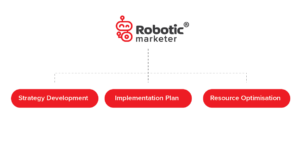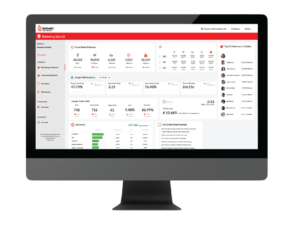Maximising Your Marketing Success with Robotic Marketer: A Comprehensive Guide
A well-defined and strategically executed marketing plan is crucial for businesses to thrive, particularly in today’s uncertain market. With the help of Robotic Marketer, an AI-powered marketing strategy technology platform, you can now develop a comprehensive marketing strategy and implementation plan that ensures optimal time and resource allocation month by month in a matter of minutes and start executing marketing campaigns aligned to business goals.
Additionally, Robotic Marketer’s integrated digital dashboard offers a range of powerful features, such as CRM/email marketing/marketing automation/Google Analytics/Advertising integrations, social media insights, influencer lists, content suggestions, and performance analysis, to enhance your marketing efforts and gain a competitive edge.
To ensure that you make the most of your marketing strategy, let’s explore how to leverage these tools and maximise your ROI.

Developing a Comprehensive Marketing Strategy:
Strategy Development: Begin by collaborating with Robotic Marketer to develop a comprehensive marketing strategy that aligns with your business goals and target audience. Simply go online, and start inputting information about your company and target audience and the technology will do the rest!
Implementation Plan: Utilise the implementation plan provided by Robotic Marketer to allocate time and resources effectively month by month, ensuring a systematic approach to your marketing activities. This ensures that you know each month exactly what you have to do, and you can ensure that you have the resources and budget to do so!
Resource Optimisation: Leverage Robotic Marketer’s AI capabilities to identify areas of resource optimisation, such as automating repetitive tasks, streamlining processes, and enhancing efficiency.
 Harnessing the Power of the Digital Dashboard:
Harnessing the Power of the Digital Dashboard:
CRM Integration: Seamlessly integrate your CRM system with the digital dashboard to track and manage customer interactions, leads, and conversions effectively.
e-Marketing and Social Media Insights: Leverage the dashboard’s capabilities to monitor and analyse the performance of your email marketing campaigns, social media engagements, and audience interactions, enabling data-driven decision-making.
Influencer Lists: Access curated lists of influencers within your industry to expand your reach, build meaningful connections, and amplify your brand’s presence.
Content Suggestions: Generate engaging content ideas with the help of Robotic Marketer’s suggested blog headings, popular hashtags, and key phrases based on your target audience and keywords.
Performance Analysis: Leverage the comprehensive web performance analysis provided by the digital dashboard to gain valuable insights into your own company’s performance, as well as that of your competitors. Identify areas for improvement, capitalise on emerging trends, and optimise your marketing strategies accordingly.

Making the Most of Social Media and Web Performance Analysis:
Social Media Insights: Monitor key social media metrics, such as engagement rates, follower growth, and content reach, to gauge the effectiveness of your social media campaigns. Identify trends, adjust your content strategy, and engage with your audience accordingly.
Web Performance Analysis: Track and analyse website metrics, including traffic sources, bounce rates, conversion rates, and user behavior, to gain a comprehensive understanding of your website’s performance. Identify opportunities for optimisation, refine user experiences, and drive better results.
Competitor Analysis: Benchmark your performance against competitors by comparing social media metrics, website traffic, and content engagement. Leverage these insights to identify areas of competitive advantage, understand market trends, and refine your marketing approach.
By leveraging Robotic Marketer’s comprehensive marketing strategy and implementation plan, along with the integrated digital dashboard, businesses can unlock their full marketing potential. Streamline your marketing activities, optimise resource allocation, and gain actionable insights through CRM integration, social media and web performance analysis, influencer lists, and content suggestions. With the power of AI and data-driven decision-making, you can take your marketing efforts to new heights and achieve exceptional results in today’s competitive landscape.

12-Month Post-Strategy Development Marketing Planner
Month 1:
- Finalise marketing strategy implementation plan.
- Launch initial demand generation campaign to generate leads.
- Create a content calendar for blog posts and social media updates.
- Utilise Robotic Marketer’s media lists, event lists, and LinkedIn/Facebook groups to amplify content reach.
- Set up weekly check-ins on the Robotic Marketer digital dashboard for monitoring progress.
- Implement weekly reporting from the digital dashboard to provide management with comprehensive insights.
Month 2:
- Execute demand generation campaign, monitor results, and optimise as needed.
- Publish blog content aligned with the marketing strategy.
- Engage with the audience on social media platforms.
- Leverage Robotic Marketer’s media lists, event lists, and LinkedIn/Facebook groups for content sharing.
- Analyse weekly check-ins on the digital dashboard and make data-driven adjustments.
Month 3:
- Plan and execute a targeted event marketing campaign.
- Explore partnerships for co-hosted webinars/seminars.
- Leverage public relations opportunities to increase brand visibility.
- Develop sales enablement materials and align them with ongoing marketing activities.
- Utilise Robotic Marketer’s media lists, event lists, and social media groups for event promotion and content sharing.
- Continuously monitor performance through the digital dashboard and provide weekly reporting for management.
Month 4:
- Evaluate the success of the event marketing campaign and make necessary adjustments.
- Continue publishing relevant blog content and engaging on social media.
- Explore opportunities to leverage Robotic Marketer’s media lists, event lists, and LinkedIn/Facebook groups for expanded content distribution.
- Utilise AI-driven analytics on the digital dashboard to identify content gaps and opportunities for improvement.
- Conduct weekly check-ins on the digital dashboard to ensure campaign effectiveness.
Month 5:
- Conduct webinars/seminars to educate and engage the target audience.
- Develop and distribute press releases to gain media coverage.
- Leverage Robotic Marketer’s media lists and event lists to identify speaking opportunities.
- Engage in media interviews or thought leadership articles for PR purposes.
- Provide the sales team with ongoing training and enablement support.
- Monitor webinar/seminar performance through the digital dashboard and provide management with weekly reports.
Month 6:
- Evaluate the impact of webinars/seminars and refine the strategy.
- Foster relationships with industry influencers for increased brand exposure.
- Develop case studies or success stories to showcase the effectiveness of your offerings.
- Leverage Robotic Marketer’s media lists, event lists, and social media groups for content sharing and influencer collaboration.
- Utilise AI-driven analytics on the digital dashboard to optimise content delivery and engagement.
- Conduct weekly check-ins on the digital dashboard to track progress and identify areas for improvement.
Month 7:
- Plan and execute a customer-focused event or networking opportunity.
- Explore opportunities for guest posting on relevant industry blogs.
- Engage in media collaborations or interviews for wider brand exposure.
- Leverage Robotic Marketer’s media lists, event lists, and LinkedIn/Facebook groups for event promotion and content sharing.
- Monitor event performance through the digital dashboard and provide weekly reporting to management.
- Conduct weekly check-ins on the digital dashboard to ensure campaign effectiveness.
Month 8:
- Assess the impact of the customer-focused event and gather feedback.
- Continuously publish valuable blog content and engage on social media.
- Leverage AI to personalise content delivery through Robotic Marketer.
- Utilise Robotic Marketer’s media lists, event lists, and social media groups to amplify content reach and engagement.
- Analyse weekly check-ins on the digital dashboard and make data-driven adjustments.
Month 9:
- Identify industry conferences or trade shows to attend or sponsor.
- Seek speaking opportunities at relevant industry events.
- Launch targeted PR campaigns to position the brand as an industry leader.
- Evaluate and optimise the effectiveness of sales enablement materials.
- Utilise Robotic Marketer’s media lists and event lists to maximise event exposure.
- Monitor performance through the digital dashboard and provide weekly reporting for management.
Month 10:
- Participate in selected industry conferences or trade shows.
- Publish thought leadership articles or guest posts on prominent industry platforms.
- Engage in media collaborations or interviews for wider brand exposure.
- Leverage Robotic Marketer’s media lists, event lists, and social media groups for increased visibility.
- Analyse weekly check-ins on the digital dashboard and make data-driven adjustments.
Month 11:
- Analyse the impact of participating in industry conferences or trade shows.
- Evaluate the ROI of PR efforts and refine the strategy as needed.
- Continue to produce valuable blog content and engage with the audience.
- Utilise AI to scale content capabilities through Robotic Marketer.
- Utilise Robotic Marketer’s media lists, event lists, and social media groups for content distribution.
- Conduct weekly check-ins on the digital dashboard to track performance and provide management with comprehensive reports.
Month 12:
- Conduct a comprehensive marketing performance review.
- Identify key learnings and successes to inform future strategies.
- Develop a roadmap for the next 12 months based on insights gained.
- Continuously optimise and refine marketing activities for ongoing growth.
- Utilise Robotic Marketer’s data-driven insights to shape future marketing initiatives.
- Provide weekly reporting from the digital dashboard to evaluate overall campaign success.
As you progress through these 12 months, the collaboration with Robotic Marketer’s tools, such as media lists, event lists, LinkedIn/Facebook groups, and the digital dashboard, will ensure streamlined execution, data-driven decision-making, and enhanced campaign performance. Stay aligned with your objectives, monitor results, and leverage the power of AI to achieve remarkable marketing outcomes.

Checklist: Implementing a Robotic Marketer Marketing Strategy
- Define your business objectives: Clearly outline your marketing goals and objectives that align with your overall business strategy.
- Collaborate with Robotic Marketer: Engage with the Robotic Marketer team to develop a comprehensive marketing strategy tailored to your business needs.
- Allocate time and resources: Create a realistic implementation plan that outlines the necessary time and resources required for each marketing activity.
- Integrate CRM system: Seamlessly integrate your CRM system with the Robotic Marketer digital dashboard for efficient tracking and management of customer interactions, leads, and conversions.
- Utilise eMarketing tools: Leverage the eMarketing capabilities provided by Robotic Marketer to streamline and automate your email marketing campaigns.
- Leverage social media insights: Utilise the digital dashboard to monitor and analyse the performance of your social media activities. Identify trends, engagement rates, and opportunities for improvement.
- Engage with influencers: Explore the influencer lists available on Robotic Marketer’s platform to identify key industry influencers and build meaningful connections.
- Generate compelling content: Utilise the content suggestions provided by Robotic Marketer to create engaging blog headings, relevant hashtags, and key phrases that resonate with your target audience.
- Monitor web performance: Leverage the web performance analysis tools on the digital dashboard to track website metrics, identify traffic sources, and optimise user experiences.
- Conduct competitor analysis: Benchmark your performance against competitors by analysing their social media metrics, website traffic, and content engagement. Identify areas of competitive advantage and refine your marketing approach.
- Utilise AI-driven insights: Capitalise on the AI capabilities of Robotic Marketer to gain data-driven insights and make informed decisions regarding your marketing strategies.
- Weekly check-ins on the digital dashboard: Stay proactive by conducting weekly check-ins on the digital dashboard to monitor progress, track performance, and make necessary adjustments.
- Provide management reporting: Use the reporting features of the digital dashboard to provide comprehensive reports to management, showcasing the progress, outcomes, and success of your marketing activities.
- Scale content delivery: Explore how AI technologies can help scale your content creation and distribution processes through Robotic Marketer, enabling you to reach a wider audience and maximise your marketing impact.
- Ensure ongoing collaboration: Foster a collaborative relationship with the Robotic Marketer team, seeking their guidance and support throughout the implementation process.
By following this checklist, your marketing team can effectively implement a Robotic Marketer marketing strategy, leveraging the platform’s capabilities to drive better outcomes, streamline processes, and achieve your marketing objectives.


